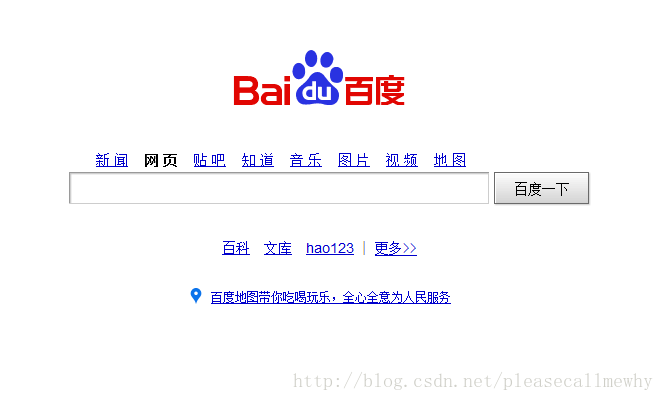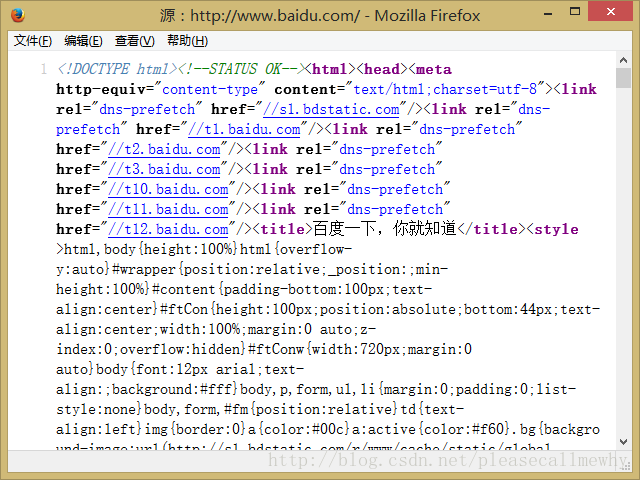 Java
Java
 javaTutorial
javaTutorial
 Write Java with zero foundation and practice Zhihu crawler first with Baidu homepage
Write Java with zero foundation and practice Zhihu crawler first with Baidu homepage
Write Java with zero foundation and practice Zhihu crawler first with Baidu homepage
In the last episode, we talked about the need to use Java to make a Zhihu crawler, so this time, we will study how to use code to obtain the content of the web page.
First of all, if you have no experience with HTML, CSS, JS and AJAX, it is recommended to go to W3C (click me, click me) to learn a little bit.
Speaking of HTML, there is an issue of GET access and POST access.
If you lack understanding of this aspect, you can read this article from W3C: "GET vs. POST".
Aha, I won’t go into details here.
Then, next we need to use Java to crawl the content of a web page.
At this time, our Baidu will come in handy.
Yes, he is no longer the unknown internet speed tester, he is about to become our reptile guinea pig! ~
Let’s take a look at Baidu’s homepage first:

I believe everyone knows that a page like this now is the result of the joint work of HTML and CSS.
We right-click the page in the browser and select "View page source code":

Yes, it's something like this. This is the source code of the Baidu page.
Our next task is to use our crawler to get the same thing.
Let’s take a look at a simple source code first:
import java.io.*;
import java.net.*;
public class Main {
public static void main(String[] args) {
// 定义即将访问的链接
String url = "http://www.baidu.com";
// 定义一个字符串用来存储网页内容
String result = "";
// 定义一个缓冲字符输入流
BufferedReader in = null;
try {
// 将string转成url对象
URL realUrl = new URL(url);
// 初始化一个链接到那个url的连接
URLConnection connection = realUrl.openConnection();
// 开始实际的连接
connection.connect();
// 初始化 BufferedReader输入流来读取URL的响应
in = new BufferedReader(new InputStreamReader(
connection.getInputStream()));
// 用来临时存储抓取到的每一行的数据
String line;
while ((line = in.readLine()) != null) {
//遍历抓取到的每一行并将其存储到result里面
result += line;
}
} catch (Exception e) {
System.out.println("发送GET请求出现异常!" + e);
e.printStackTrace();
}
// 使用finally来关闭输入流
finally {
try {
if (in != null) {
in.close();
}
} catch (Exception e2) {
e2.printStackTrace();
}
}
System.out.println(result);
}
}The above is the Main method of Java simulating Get access to Baidu.
You can run it and see the result:
Aha, it is exactly the same as what we saw with the browser before. At this point, the simplest crawler is ready.
But such a big pile of things may not all be what I want. How can I grab what I want from it?
Take Baidu’s big paw logo as an example.
Temporary need:
Get the picture link of the big paw of Baidu Logo.
First let’s talk about the browser viewing method.
Right-click the image and select Inspect Elements (Firefox, Google, and IE11 all have this function, but the names are different):

Aha, you can see that under the siege of a lot of divs The poor img tag.
This src is the link to the image.
So how do we do it in java?
Please note in advance that in order to facilitate the demonstration of the code, all codes are not encapsulated by classes, please understand.
Let’s first encapsulate the previous code into a sendGet function:
import java.io.*;
import java.net.*;
public class Main {
static String sendGet(String url) {
// 定义一个字符串用来存储网页内容
String result = "";
// 定义一个缓冲字符输入流
BufferedReader in = null;
try {
// 将string转成url对象
URL realUrl = new URL(url);
// 初始化一个链接到那个url的连接
URLConnection connection = realUrl.openConnection();
// 开始实际的连接
connection.connect();
// 初始化 BufferedReader输入流来读取URL的响应
in = new BufferedReader(new InputStreamReader(
connection.getInputStream()));
// 用来临时存储抓取到的每一行的数据
String line;
while ((line = in.readLine()) != null) {
// 遍历抓取到的每一行并将其存储到result里面
result += line;
}
} catch (Exception e) {
System.out.println("发送GET请求出现异常!" + e);
e.printStackTrace();
}
// 使用finally来关闭输入流
finally {
try {
if (in != null) {
in.close();
}
} catch (Exception e2) {
e2.printStackTrace();
}
}
return result;
}
public static void main(String[] args) {
// 定义即将访问的链接
String url = "http://www.baidu.com";
// 访问链接并获取页面内容
String result = sendGet(url);
System.out.println(result);
}
}This looks a little neater, please forgive me for my obsessive-compulsive disorder.
The next task is to find the link to the picture from a lot of things obtained.
The first method we can think of is to use the indexof function to search for String substrings in the string result of the page source code.
Yes, this method can slowly solve this problem, such as directly indexOf("src") to find the starting serial number, and then get the ending serial number in a hurry.
But we can’t use this method all the time. After all, straw sandals are only suitable for walking around. Later, we still need to cut off the prosthetic leg to hold the head.
Please forgive my intrusion and continue.
So how do we find the src of this picture?
Yes, as the audience below said, regular matching.
If any students are not sure about regular expressions, you can refer to this article: [Python] Web Crawler (7): Regular Expressions Tutorial in Python.
Simply put, regular expression is like matching.
For example, three fat men are standing here, wearing red clothes, blue clothes, and green clothes.
The rule is: catch the one in green!
Then the fat green man was caught alone.
It’s that simple.
However, the regular grammar is still extensive and profound. It is inevitable that you are a little confused when you first come into contact with it.
I recommend a regular online testing tool to everyone: regular expression online test.
With regularity as a magic weapon, how to use regularity in java?
The above is the content of writing Java Zhihu crawler with zero foundation. First, practice with Baidu homepage. For more related content, please pay attention to the PHP Chinese website (www.php.cn)!

Hot AI Tools

Undresser.AI Undress
AI-powered app for creating realistic nude photos

AI Clothes Remover
Online AI tool for removing clothes from photos.

Undress AI Tool
Undress images for free

Clothoff.io
AI clothes remover

Video Face Swap
Swap faces in any video effortlessly with our completely free AI face swap tool!

Hot Article

Hot Tools

Notepad++7.3.1
Easy-to-use and free code editor

SublimeText3 Chinese version
Chinese version, very easy to use

Zend Studio 13.0.1
Powerful PHP integrated development environment

Dreamweaver CS6
Visual web development tools

SublimeText3 Mac version
God-level code editing software (SublimeText3)

Hot Topics
 1664
1664
 14
14
 1421
1421
 52
52
 1316
1316
 25
25
 1266
1266
 29
29
 1239
1239
 24
24
 Break or return from Java 8 stream forEach?
Feb 07, 2025 pm 12:09 PM
Break or return from Java 8 stream forEach?
Feb 07, 2025 pm 12:09 PM
Java 8 introduces the Stream API, providing a powerful and expressive way to process data collections. However, a common question when using Stream is: How to break or return from a forEach operation? Traditional loops allow for early interruption or return, but Stream's forEach method does not directly support this method. This article will explain the reasons and explore alternative methods for implementing premature termination in Stream processing systems. Further reading: Java Stream API improvements Understand Stream forEach The forEach method is a terminal operation that performs one operation on each element in the Stream. Its design intention is
 PHP: A Key Language for Web Development
Apr 13, 2025 am 12:08 AM
PHP: A Key Language for Web Development
Apr 13, 2025 am 12:08 AM
PHP is a scripting language widely used on the server side, especially suitable for web development. 1.PHP can embed HTML, process HTTP requests and responses, and supports a variety of databases. 2.PHP is used to generate dynamic web content, process form data, access databases, etc., with strong community support and open source resources. 3. PHP is an interpreted language, and the execution process includes lexical analysis, grammatical analysis, compilation and execution. 4.PHP can be combined with MySQL for advanced applications such as user registration systems. 5. When debugging PHP, you can use functions such as error_reporting() and var_dump(). 6. Optimize PHP code to use caching mechanisms, optimize database queries and use built-in functions. 7
 PHP vs. Python: Understanding the Differences
Apr 11, 2025 am 12:15 AM
PHP vs. Python: Understanding the Differences
Apr 11, 2025 am 12:15 AM
PHP and Python each have their own advantages, and the choice should be based on project requirements. 1.PHP is suitable for web development, with simple syntax and high execution efficiency. 2. Python is suitable for data science and machine learning, with concise syntax and rich libraries.
 PHP vs. Other Languages: A Comparison
Apr 13, 2025 am 12:19 AM
PHP vs. Other Languages: A Comparison
Apr 13, 2025 am 12:19 AM
PHP is suitable for web development, especially in rapid development and processing dynamic content, but is not good at data science and enterprise-level applications. Compared with Python, PHP has more advantages in web development, but is not as good as Python in the field of data science; compared with Java, PHP performs worse in enterprise-level applications, but is more flexible in web development; compared with JavaScript, PHP is more concise in back-end development, but is not as good as JavaScript in front-end development.
 PHP vs. Python: Core Features and Functionality
Apr 13, 2025 am 12:16 AM
PHP vs. Python: Core Features and Functionality
Apr 13, 2025 am 12:16 AM
PHP and Python each have their own advantages and are suitable for different scenarios. 1.PHP is suitable for web development and provides built-in web servers and rich function libraries. 2. Python is suitable for data science and machine learning, with concise syntax and a powerful standard library. When choosing, it should be decided based on project requirements.
 PHP's Impact: Web Development and Beyond
Apr 18, 2025 am 12:10 AM
PHP's Impact: Web Development and Beyond
Apr 18, 2025 am 12:10 AM
PHPhassignificantlyimpactedwebdevelopmentandextendsbeyondit.1)ItpowersmajorplatformslikeWordPressandexcelsindatabaseinteractions.2)PHP'sadaptabilityallowsittoscaleforlargeapplicationsusingframeworkslikeLaravel.3)Beyondweb,PHPisusedincommand-linescrip
 Java Program to Find the Volume of Capsule
Feb 07, 2025 am 11:37 AM
Java Program to Find the Volume of Capsule
Feb 07, 2025 am 11:37 AM
Capsules are three-dimensional geometric figures, composed of a cylinder and a hemisphere at both ends. The volume of the capsule can be calculated by adding the volume of the cylinder and the volume of the hemisphere at both ends. This tutorial will discuss how to calculate the volume of a given capsule in Java using different methods. Capsule volume formula The formula for capsule volume is as follows: Capsule volume = Cylindrical volume Volume Two hemisphere volume in, r: The radius of the hemisphere. h: The height of the cylinder (excluding the hemisphere). Example 1 enter Radius = 5 units Height = 10 units Output Volume = 1570.8 cubic units explain Calculate volume using formula: Volume = π × r2 × h (4
 PHP: The Foundation of Many Websites
Apr 13, 2025 am 12:07 AM
PHP: The Foundation of Many Websites
Apr 13, 2025 am 12:07 AM
The reasons why PHP is the preferred technology stack for many websites include its ease of use, strong community support, and widespread use. 1) Easy to learn and use, suitable for beginners. 2) Have a huge developer community and rich resources. 3) Widely used in WordPress, Drupal and other platforms. 4) Integrate tightly with web servers to simplify development deployment.



